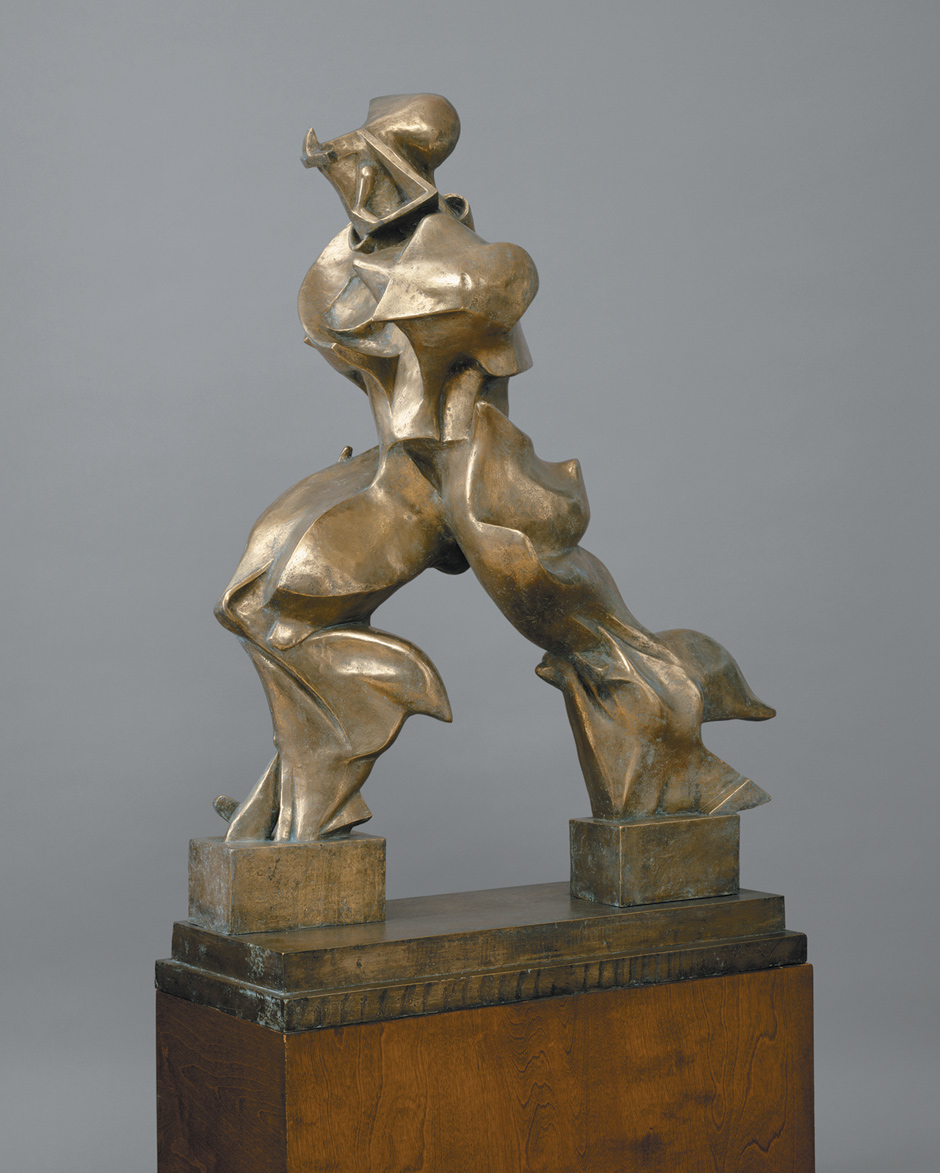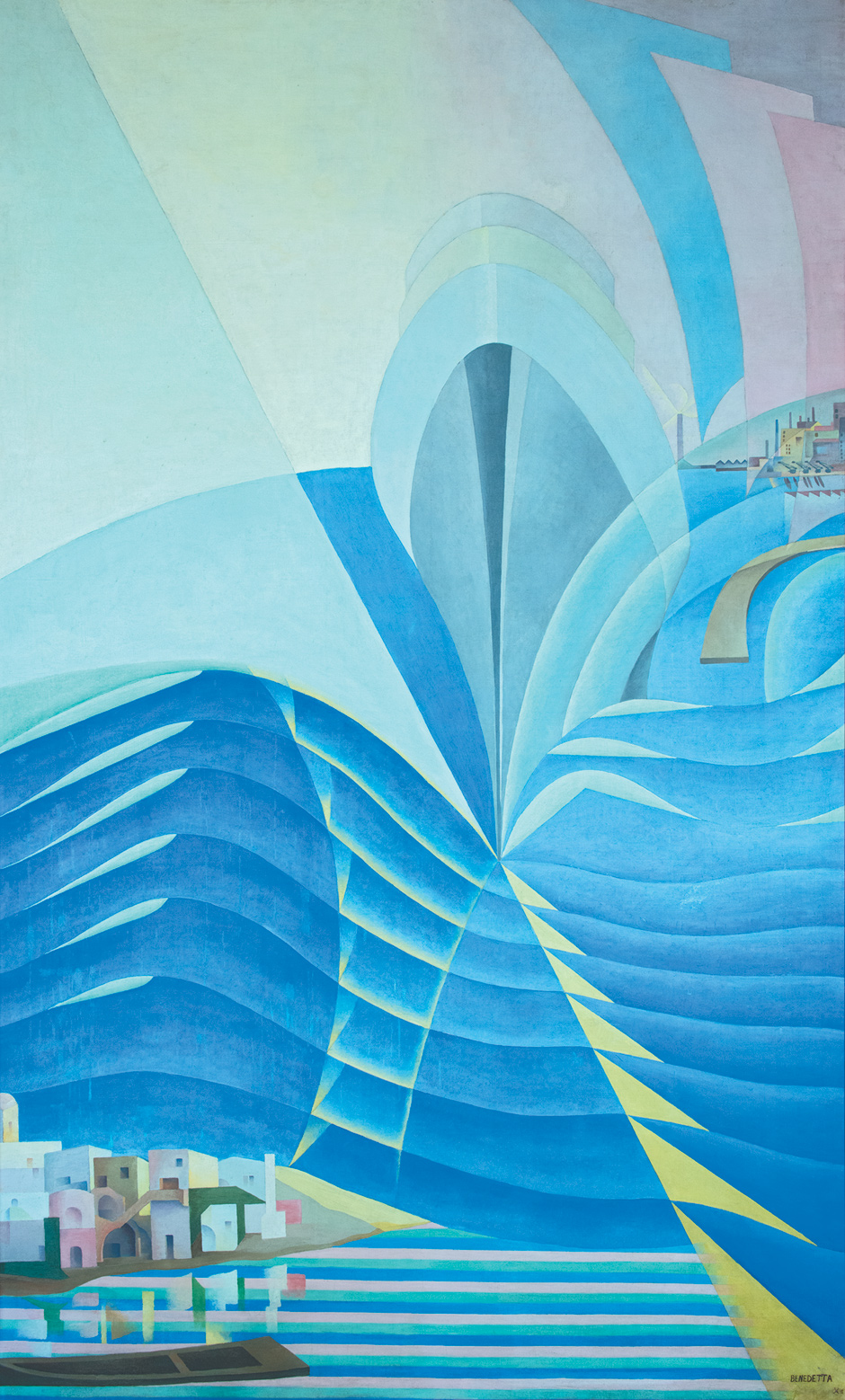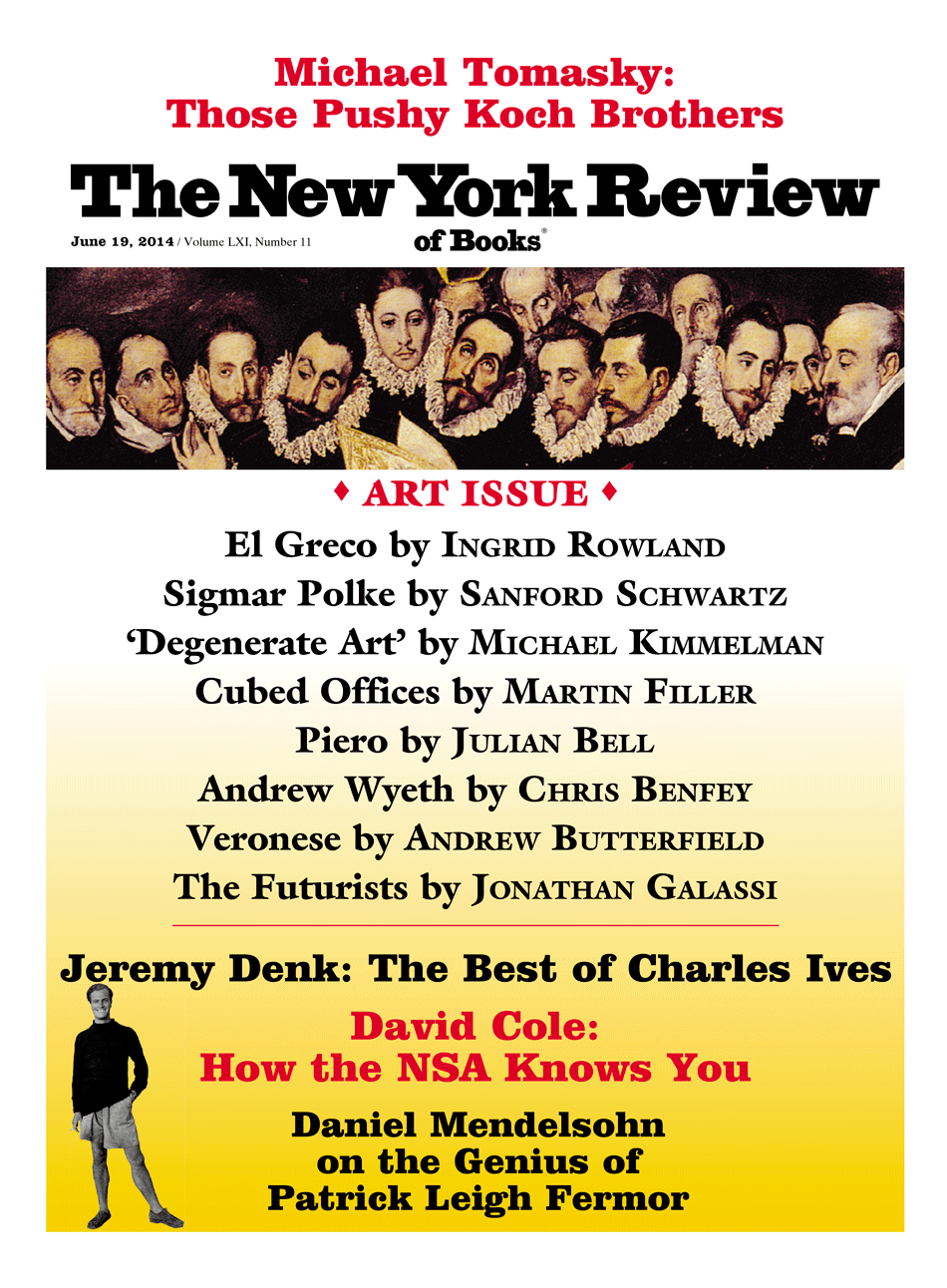An enormous exhibition of the Italian Futurist movement occupies the snail-shell of the Guggenheim Museum this spring and summer. The Futurists were dedicated to motion—but not the meditative pace that Frank Lloyd Wright’s ramp imposes on the viewer; more the revving of a Lamborghini, or better yet a Ducati motorcycle, relentlessly powering up, up, up and away, its engine knocking, spewing exhaust, mowing down everything in its path. The Futurists believed in the machine, in making a great big fuss, in being young. For a brief moment, they were arguably the most influential aesthetic provocateurs in the world.
The show starts with the movement’s most familiar work, Umberto Boccioni’s Unique Forms of Continuity in Space (1913), a spirally torqued image of a striding bronze figure trailed by planar extrusions that indicate the pathways of its forward progress like sails or scarves. Boccioni’s dinamismo plastico aspired “to fix human forms in movement” and was interested in vigor, not grace (a squashed, bulbous self-portrait head of the same period is titled Antigrazioso, “Antigraceful”). Even so, Unique Forms is one of the most arresting and beautiful figures in modernist art.
The representation of speed, figured and abstract, was one of the Futurists’ prime aesthetic projects, underpinned by a philosophy of creative destruction that owed its expression to one man, the poet and publicist Filippo Tommaso Marinetti, its guru and pope, around whom the entire enterprise pivoted and whose death brought it to an end in 1944. Marinetti was born in 1876 and brought up in Alexandria, Egypt, where he received a French education. As a young poet he was a standard-issue symbolist until an encounter with an engine, mythologized in his “Foundation and Manifesto of Futurism,” published in Le Figaro in 1909, changed everything:
My friends and I had stayed up all night, sitting beneath the lamps of a mosque, whose star-studded, filigreed brass domes resembled our souls,…listening to the tedious mumbled prayers of an ancient canal and the creaking bones of dilapidated palaces.
Their Orientalist idyll is disturbed by “the sudden roar of ravening motorcars,” and Marinetti and friends leave the mosque in hot pursuit (“all the myths and mystical ideals are behind us. We’re about to witness the birth of a Centaur”). “Like young lions,” they go chasing “after Death” and end up in a ditch. Marinetti apostrophized:
O mother of a ditch, brimful with muddy water!… How I relished your strength-giving sludge that reminded me so much of the saintly black breast of my Sudanese nurse…. When I got myself up—soaked, filthy, foul-smelling rag that I was—from beneath my overturned car, I had a wonderful sense of my heart being pierced by the red-hot sword of joy!1
Marinetti had found his way out of the cul-de-sac of too much civilization. The Futurist manifesto that follows on his dream, the first of many, glorifies “aggressive action” and asserts that “a roaring motorcar…is more beautiful than the Winged Victory of Samothrace” (never mind that Boccioni’s sculpture will uncannily resemble it). “There is no longer any beauty except the struggle,” Marinetti declared. War is “the sole cleanser of the world.”
Marinetti was a strong writer and even more a supremely gifted publicist. Lucy Hughes-Hallett, in her biography of Gabriele D’Annunzio (1863–1938), the decadent poet and agitator who created much of the symbology that Mussolini lifted for Fascism, calls Marinetti D’Annunzio’s “noisiest and most brilliant disciple,” though she says Marinetti never acknowledged this.2 Much of what Marinetti preached—the love of speed, the courting of death, ultra-nationalist politics, the efficacy of war as social purification—derived from what D’Annunzio and others, too, were espousing, on both sides of the English Channel. Marinetti’s genius was to harness his convictions to an aesthetic movement that shouted its absolute newness at the top of its voice. He called himself “the Caffeine of Europe.”
Marinetti and his cohorts organized serate, or evenings, proto-Happenings that exemplified and promoted the Futurist assault on the status quo. These were attended by students in dress clothes who had the time of their lives making absurdist noise and insulting their audience like so many artsy frat boys intent on doing down their parents’ stifling world—Giovanni Giolitti’s tasseled, overstuffed bourgeois “Italietta” which D’Annunzio, though he epitomized it, also felt the need to escape and transform.
The Futurists wanted to sweep away what the poet Guido Gozzano called “le buone cose di pessimo gusto,” good things in the worst of taste, and replace them with an insolent, steely, polluting Machine Age. “Time and space ended yesterday,” Marinetti intoned. “We already live in the absolute”—that is, in a state of perpetual youth menaced only by death. “In every young man Marinetti’s gunpowder,” Vladimir Mayakovsky wrote. Marinetti not only wanted to end the monarchy and “de-Vaticanize”; he also argued for replacing the senate with an assembly of the young.
Advertisement
Like André Breton after him, Marinetti attracted and dominated a group of gifted artists, among them Boccioni and Luigi Russolo, and Carlo Carrà and Gino Severini, who had begun as Divisionists, Italian pointillists who got interested in reducing motion and simultaneity to two dimensions, suggested in part by the chronophotography of Étienne-Jules Marey. They traveled to Paris at Marinetti’s behest and encountered the Cubists, but though the Futurists borrowed the Cubist fracturing of planes, they remained unimpressed with Cubism’s static and backward-looking focus on traditional subject matter like nudes, bowls of fruit, and guitars (the Italian adjective passatista, or passist, is redolent of Futurist disdain for anything old hat). Indeed, Marcel Duchamp’s Nude Descending a Staircase, No. 2 (1912) seems tongue-in-cheek and nonchalant next to the dead-serious, virtually abstract monochrome violence of Carrà’s and Boccioni’s teacher Giacomo Balla, whose Dynamic Expansion + Speed and Speeding Car were painted the following year.
It’s hard to overstate the influence of early Futurism on modernist movements everywhere. The Russian literary avant-garde appropriated its name and its insolence (Mayakovsky, Khlebnikov, and company called their own manifesto “A Slap in the Face of Public Taste”). Apollinaire removed the punctuation from the proofs of Alcools (1913) in response to Marinetti’s attacks on traditional typography, and in Britain Wyndham Lewis’s Vorticism was partly conceived in opposition to Futurism. His collaborator Ezra Pound called Marinetti a “corpse,” though he later admitted that “the movement that I, Eliot, Joyce and others began in London would not have existed without Futurism.”
Italian Futurism, too, was largely a literary movement, in that among its most significant artifacts are the polemical magazines in which its endless battles were fought and the countless manifestos that Marinetti and his disciples produced, on everything, including literature, politics, painting, sculpture, music, noise, architecture, theater, cinema, dance, lust (“lust is the act of creation, and is Creation itself”), Trieste, Florence, Rome, and Venice (“We rush to fill its stinking little canals, with the rubble of its crumbling, pockmarked palaces. We’ll set fire to the gondolas”). Particularly delightful are the parole in libertà, or words in freedom, concrete poems of words and letters made into images, after Stéphane Mallarmé’s “Un coup de dés”—though these are almost always confined to onomatopoetic representation and in fact not as fully syntax-free, or as truly experimental, as Dadaist wordplay, for example, would prove to be. This, in fact, is generally true of the Futurists’ experimentalism: it goes only so far.
Heroic Futurism was naturally politically radical, drawing inspiration, like the syndicalists and many others, from Georges Sorel’s incendiary Reflections on Violence (1908). Some of the greatest Futurist paintings, such as Boccioni’s The City Rises and Carrà’s Funeral of the Anarchist Galli, both created in 1910–1911, explore simultaneity in oneirically chromatic portrayals of social conflict in the modern city. But Marinetti’s sights were set on a more totalized transformation:
We are aspiring to the creation of an inhuman type, one in which moral suffering, generosity, affect, and love will be abolished…naturally cruel, omniscient, and combative.
His “wireless imagination” was militantly anti-Christian and antihumanist in its glorification of mechanized power. Frankly misogynistic (the Futurists would have said antifeminine), the movement was antierotic, too: sex was a mechanical act necessary for procreation. All in all, they were suspicious of the body, which after all is about as old hat as you can get. As Patrizia Veroli writes in the catalog, Futurist dance was a failure because it approached the performer’s body “as a machine for producing certain type [sic] of signals on the stage.” The robotic costumes impeded the dancers’ movements.
“With us begins the reign of the man whose roots are cut, the multiplied man who merges himself with iron, is fed by electricity, and no longer understands anything except the sensual delight of danger and quotidian heroism,” Marinetti wrote in 1915. He had got the war he wanted, “the finest Futurist poem that has materialized till now.” “Marciare non marcire!” (March, don’t rot!) went the Futurist slogan, and Futurist painting early on in the conflict, like Severini’s Armored Train in Action (1915), is bright-hued and picturesque, devoid of Balla’s murderous intensity, as if its subject were almost incidental. But Boccioni and Antonio Sant’Elia, two of the pillars of the movement, died in the “red vacation,” and by the time it was over, Futurism was being shoved aside by farther-out avant-gardes. The Dadaists declared in their own 1921 manifesto that “Futurism has died. Of what? Of Dada.”
Marinetti was a believer in the irredentist cause, which sought to recover historically Italian territory from the Austrians and others, and he enthusiastically backed D’Annunzio’s seizure of Fiume in 1919. Like D’Annunzio, however, he was outmaneuvered by Mussolini, who seized power for himself in 1922. Marinetti had hoped to bring about a revolution by way of art; instead he found himself currying favor with the Fascists, insisting that “the political revolution must support the artistic revolution.” The regime, however, was more interested in promoting a neoclassical aesthetic that invoked the imperial Roman past. Marinetti supported Mussolini for the rest of his life, even in his last ignominious months in the Republic of Salò, but the Futurists only occasionally received the state commissions they sought.
Advertisement
The continuation of the movement after the war was called “Second Futurism.” It represents a disheartening falling off, though the exhibition cheerily proceeds as if nothing has been lost. Ivo Pannaggi’s Speeding Train (1922) feels almost like an advertisement for the Italian railway system when compared to Balla’s and Boccioni’s and Carrà’s menacing early work. Many of the best of Marinetti’s first team abandoned him. Carrà, inspired by Giotto to return to the human figure, and the melancholy Mario Sironi were drawn to Giorgio de Chirico’s myth-haunted Metaphysical school, which eventually flowed into Surrealism.
The Second Futurists became preoccupied with a debased version of the Wagnerian “total work of art,” and with what the sculptor George Segal has referred to as “the aesthetics that has to do with living in modern cities.” Futurist living rooms, tea sets, textiles, and clothes were displayed and marketed in case d’arte, or houses of art, and the exhibition abounds in examples of these attempts to create entire environments, meant to utterly isolate their consumers from contamination by passatista influences. In essence, Second Futurism devolves into commercially digestible modernism pure and simple, a kind of Italian Art Deco.
Perhaps the most representative Second Futurist is Fortunato Depero, artist, stage designer, and advertising man, who created everything from painting and sculpture to toys to dishware as well as (abortive) stage sets for the Ballets Russes, spent time in New York, and predicted that the art of the future would be advertising. His cartoonlike Stormy Patriotic Marinetti: Psychological Portrait (1924)—one of a number of promotional images of the fearless leader in the exhibition—has red, white, and green thunderbolts emerging from Marinetti’s head. Depero’s most enduring contribution may be his sleek advertising for Campari; their characteristic bottle is of his design. There is a childlike playfulness and decorativeness to his work that is utterly alien from heroic Futurism’s grim determination, though his faceless folkloric figures feel joyless, too, robotic Babes in Toyland.
In spite of Futurism’s hostility to the feminine, there were important female members of the movement, among them Marinetti’s wife Benedetta Cappa, who signed herself simply Benedetta. Her Speeding Motorboat (1923–1924), its wake breaking up the blue and yellow half-diamond surface of the sea as it disappears into the far horizon, is a marvel of wit and elegance that makes a summer idyll in the Aeolian Islands into a charming Futurist motion study (the image was reproduced on a plate).
Benedetta’s ethereal, pacific wall paintings for the Palermo Post Office (1933–1934), one of the Futurists’ few public commissions, are the largest works in the show. These “syntheses” of the various forms of modern communication are gorgeous Futurist travel posters, dreamlike evocations of a timeless, unpeopled Italy seen as if from space that stand among the better examples of the aeropittura, or aeropainting, that dominates late-stage Futurism.
Later Futurist work is sadly docile. Gerardo Dottori, Tullio Crali, et al. use their considerable talents to glorify not only the airplane—the faster, noisier automobile, which naturally obsessed the Futurists—but the Fascist heroes who fly it. Their paintings imitate Filippo Masoero’s exciting stunt photography and at times could even be mistaken for it. Balla, in some ways the most representative Futurist artist of all, who early on gave up realism in favor of brilliantly original explorations of synthetic form, ends up creating sterile Fascist propaganda. His Balbo and the Italian Transatlantic Flyers (1931) is a flat, bright, hieratic, and abstract homage to the daredevil pilot who was one of Mussolini’s top officials. The formerly strident anti-Christians start producing religious art, too, resorting to pudgy biomorphic forms in so-called arte cosmica or arte sacra influenced, like Benedetta’s syntheses, by Georgia O’Keeffe–style Surrealism.
Marinetti died in 1944 and with him the movement that had long since lost its originary zeal. When he and his fellow troublemakers were young, Futurism had reveled in youth—in death-defying propulsion, in violence and disdain. “When we reach forty, other, younger, and more courageous men will very likely toss us into the trash can, like useless manuscripts,” he’d declared at the outset. “And that’s what we want!” Before long, though, as Maria Antonella Pelizzari writes in the catalog, “the machine had become a concrete presence in everyday life rather than an emblem of a distant future.” Now, instead of endless renewal, the Futurists wanted to be insiders. Nothing remained of their adolescent need to épater le bourgeois because they’d grown up to be the bourgeois they’d always been. Futurism at its height idealized becoming; unfortunately, it became.
-
1
F.T. Marinetti: Critical Writings, edited by Günter Berghaus and translated by Doug Thompson (Farrar, Straus and Giroux, 2006). ↩
-
2
See David Gilmour’s review in these pages, March 6, 2014. ↩




